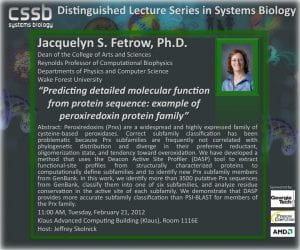 Distinguished Lecture Series Guest Speaker: Jacquelyn S. Fetrow
Distinguished Lecture Series Guest Speaker: Jacquelyn S. Fetrow
Dean of the College of Arts and Sciences
Reynolds Professor of Computational Biophysics
Departments of Physics and Computer Science
Wake Forest University
Date & Time: Tuesday, February 21, 2012, 11:00AM
Location: Marcus Nanotechnology Building, Room 1116
Host: Jeffrey Skolnick
Abstract: Peroxiredoxins (Prxs) are a widespread and highly expressed family of cysteine-based peroxidases. Correct subfamily classification has been problematic because Prx subfamilies are frequently not correlated with phylogenetic distribution and diverge in their preferred reductant, oligomerization state, and tendency toward overoxidation. We have developed a method that uses the Deacon Active Site Profiler (DASP) tool to extract functional-site profiles from structurally characterized proteins to computationally define subfamilies and to identify new Prx subfamily members from GenBank. In this work, we identify more than 3500 putative Prx sequences from GenBank, classify them into one of six subfamilies, and analyze residue conservation in the active site of each subfamily. We demonstrate that DASP provides more accurate subfamily classification than PSI-BLAST for members of the Prx family.
Additional Information: Dr. Fetrow’s research focuses on understanding how proteins work in the cell by studying the intricate relationships that exist between protein function and structure, involving communication networks both within the protein and between proteins. To achieve this her lab is developing methods and tools to aid in the early stages of drug discovery using Bioinformatics, Computational Biophysics and Systems Biology approaches.
